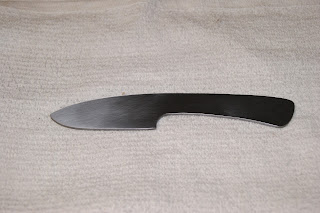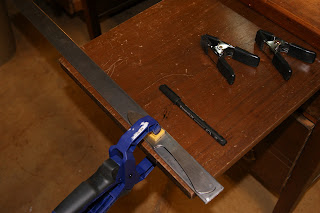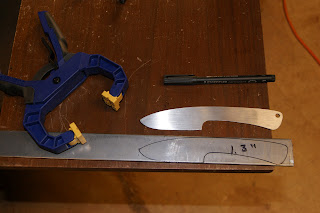Well it sure has been quite a challenging start of the new school year this semester. To start with, a decision was made to replace all faculty/staff computers in the short time frame from the end of the summer semester to the beginning of the fall semester (basically about 3 weeks). This decision was not made by the folks in IT and I imagine some tried to argue against it. But, that alone was enough to cause a lot of issues. Software updates for existing curriculum-specific programs had to be installed as well as installing software that didn't come with the new computers added to the time needed to replace all computers. And of course let's not forget the hardware. For example, my dept uses CAM (Computer-Aided-Manufacturing) software that requires a security dongle, however, the security dongles that we have at this time use the older printer parallel port. So, this detail was not considered when replacing the computer in my office. Therefore, I had no working printer because my printer was setup with the parallel port cable. I can temporarily deal without CAM but the printer is really needed! This caused quite a bit of problems because with the recent registration for the fall semester, I couldn't print out a new student's schedule and registration bill for them. I had to refer them to other people.
In addition to the new computers, a software program that faculty/staff use on campus was revamped completely. This program is used by faculty for a number of things but one of these uses is registration. But since no one had informed any faculty of the new software, very few actually knew how to operate it with the new changes. These changes also had an additional unforeseen effect on registration. Because the software was completely changed, many of the local restrictions on classes we had placed were now removed. For example we have a long 6 credit hour course split into A and B sections of 3 credit hours each. Students first had to take the A section before he/she could register into the B section. That restriction was removed with the changes and we had no less than 7 students signed up for the wrong course. But the problems didn't end there. Because we changed the curriculum the A section was no longer running. We were only running the B section to help students that had already taken the A section to complete the entire course. So 3 of those students when changing to the correct, new curriculum courses had to pay for an additional credit hour, because the new course has 4 credit hours. The other students had individual issues because they were trying to substitute a course for one of the state required courses.
The fun didn't stop there! The bookstore on our main campus had changed management and practically all of our fall semester textbook orders for my particular program were not made. This meant that nearly all of our courses started the semester without any textbooks, and some still are without them despite our third week into the semester.
And wouldn't you know it, that's not the last of it either! Because we had lost a part-time instructor to another college. A community college further west had a full-time teaching position available in machine shop and one of our part-time instructors applied for it. I can't really blame him, in fact, I'm glad that he got it. He was not working anywhere else and had no benefits or insurance. I told him that I wish I could lie to him and tell him that he's needed more in our program than theirs but I couldn't do that and he would be a fool not to take that position. So, with the loss in personnel I've had to take up two additional courses this semester. Hopefully I'll get some more help but I'm guessing that this coming spring might be even more difficult to deal with. We'll see.
This is the main reason why I've not posted anything in awhile. I was just too busy to keep up anything on the blades I'm making. Overall, I'd say that this has to be the most difficult semester starts I've ever seen, and I'm including all of the time I had taught part-time starting in 2001. It has, thankfully slowed down just a bit. So, this should lead to more posts and progress updates on the blades.
But, all of this hasn't stopped my desire to learn more about knifemaking! In fact, I had enrolled into another 4 day course at Montgomery Community College - much to the dismay of my boss who knows that I'm now behind on much (if not all) of my administration. This time I took a custom folding knife course. This covered the required steps and materials needed to make a custom folding (pocket) knife. The course was setup so that a person with a minimum amount of power equipment could complete a folder. And to the instructor's credit, that's exactly how I made it. The only equipment that I used that I don't currently own is the heat treat furnaces and the anodizing tank. But everything else can be done with a minimum of equipment, most available in most homes. The exception is the knifemaker's grinder. I own a Grizzly but I suspect that most average home owners don't have something similar.
The instructor was fun and knowledgeable and I had a good time learning his methods. But he's also full of shit. I'll explain. We were finishing up a step about midway through the process when it became very obvious that we've either skipped a step or performed it incorrectly because some of the pieces are not fitting together at all. All students' knives with one exception were just not fitting together properly - including the instructor's wife who is also a knifemaker. In fact, everyone's knife pieces were fitting together incorrectly in the exact same way. We eventually learned what was done wrong but we still had a chance to correct it and it was an internal piece so the change wasn't going to affect the final project. But according to the instructor, we must have not listened to his instruction. This step was important to the fit of each piece but we must not have followed his instruction - according to him. To which I replied, "Your full of shit!" He tried to defend his position by saying that he had 24 years of knifemaking experience and wouldn't tell students to do that. Which I again replied, "Your full of shit." I didn't really mind that a mistake was made. In fact, often I have to push some faltering students into attempting a project just so that they will make a mistake and learn from it. A student afraid of making mistakes doesn't benefit from hesitating when learning. What bothered me was the assertion that we (the students) deliberately tried a different method of completing the steps - despite the fact that no one (except the instructor's wife) had any experience. As if all other students (none of whom had any knifemaking experience) would've said to themselves, "I see the instructor's methods but I'm going to apply my own." The instructor could tell that I got angry at him and he recanted what he said and eventually stated that it's possible that he misspoke his instructions to the class. But the rest of the class went without any more of this and I had a lot of fun.
So the folding knife is a custom design with bolsters. The blade is ATS-34 steel. This is a stainless steel developed by Hitachi in Japan. The bolsters are 440C stainless. And the scales are black linen micarta. As one can see from the photos the overall length (unfolded) is approx. 6.5" and the length of the blade (from the bolsters) is just shy of 2-5/8" with the thickness at 3/32". Closed length is almost 4". The liners are titanium and the back spacer is 440C.
From these photos, it may be possible to see the jeweling I did to the inside of the titanium liners.
Micarta leaves a beautiful, random layered pattern when ground away.
The thumb-stud is easily accessible despite having ran out of time to grind into the handle a relief cut to allow better engagement.
There is some noticeable blade play at the tip when opened but the lock up is solid.
The lock up is a liner lock cut into the titanium liners. The liners were also anodized after everything was completed to them, including the jeweling. It's also worth noting that we put a ball detent into one liner and a divot into the blade that will "pull" the blade fully closed with tension. This works quite well.
I put a slight bevel along either side of the spine of the blade.
Damn I'm good!
These photos show the file work I did to the thumb rest area along the spine of the blade. I used small needle files (sometimes called jeweler's files) to cut this pattern. This is known as the vine pattern. I'm quite pleased with the result.
One can also see the discoloring of the titanium liners from anodizing. I chose a dark gold color.
Just barely fits inside my hand.
Technically the project isn't quite finished yet. I've got to grind out a section to expose the liner lock and make it easier to operate. I also need to adjust the pivot screw hidden underneath the bolsters because of the blade play - but this is minor and may only require a bit of lubrication. And, the edge isn't really that good - and it was done by the instructor! So, it still needs a few minor tweaks but otherwise it's ready for use as it is now. This was a really fun project and nearly everything done to this knife can be done at most homes. I'm really excited about future blades! I fully intend to get back into my unfinished fixed blades that I was working on and then go straight into some more folders. I just really hope that the semester will smooth out a bit and allow me the time to focus on my knifemaking. We'll see!





































